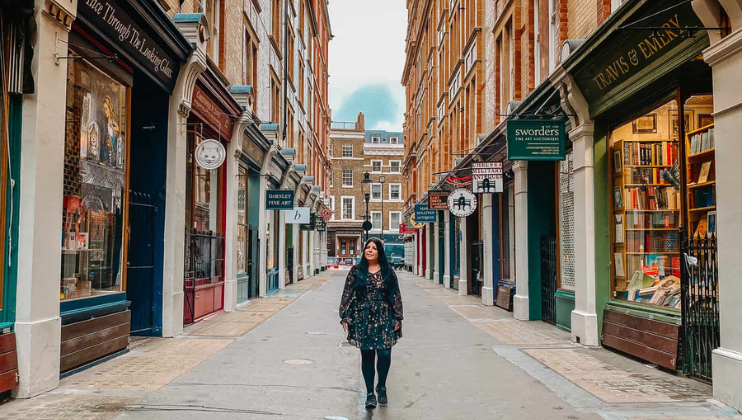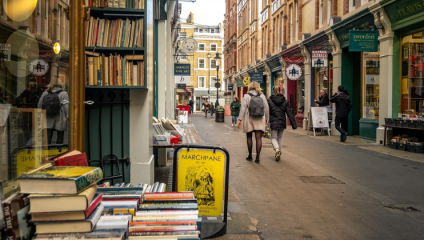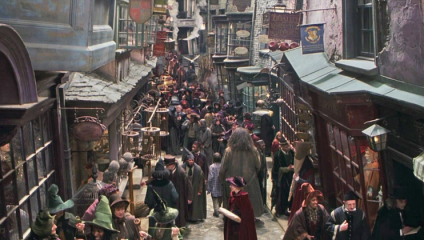The Culture Calling Guide to Cecil Court
This charming street is often referred to (by those not in-the-know) as ”London’s book street”, but it is actually, oh, so much more...

Walking from Caring Cross Road to Leicester Square you probably wouldn’t notice this inconspicuous alleyway, but turn in and you’ll find a treasure trove of eccentric and sophisticated independent shops (and Harry Potter fans!) either side of the pedestrianised walkway that looks and feels like a proper London shopping street should...
A Little History
The land in this area is still owned today by the Cecil Family, descendants of the illustrious Elizabethan statesman Robert Cecil, 1st Earl of Salisbury, who oversaw the government during the transition from Tudor to Stuart rule, and was the principal discoverer of the famous Gunpowder Plot to blow up the Houses of Parliament. His principal residence was Hatfield House in Hertfordshire, but he purchased four acres besides St Martins Lane in 1609, and it has seen some interesting figures pass through it:
A plaque at No.9 records the fact that in 1764 the young musical prodigy Wolfgang Amadeus Mozart (then nine years old) lodged in a building on the site (then a barbershop) with his family whilst on his first tour of Great Britain. The family resided there for around four months whilst the young composer played concerts in London venues, and even sold tickets from the barbershop.
It was in 1894 that Cecil Court as we know it today was built, after renovations to the existing buildings were badly needed, and it became affectionately known as ‘Bookseller Row’.
In the 1930s Cecil Court was a well-known meeting place for Jewish refugees (some have even called it the headquarters of the underground Jewish Refugee Movement) which in 1983-4 inspired R.B. Kitaj to paint Cecil Court W.C.2. (The Refugees), a work now in the Tate Collection.
Back in 1961, what is now the site of Goldsboro Books (23-25 Cecil Court) was two separate shops; No.23 was a curisoity shop selling a hotchpotch of unusual items like African tribal maps and badly stuffed beavers, medals, maps, and antique military weapons like spears, swords and knives. On March 3rd of 1961, 59-year old shop assistant Elsie Batten was found there having been stabbed to death with an antique dagger, and it was discovered that an ornamental sword had been stolen from the shop. Passers-by gave a description to police of a man who had been admiring the sword the day before the murder, and trying to sell it the day after - this was a landmark case as the first time an arrest and conviction was made on the basis of an ‘identikit’ picture, where physical descriptions of the perpetrator were given to a police artist to draw.
‘Flicker Alley’
When Cecil Court was refurbished in 1894 some of its earliest new occupiers (nestled in amongst a naval and military tailor, an artifical florist and an ostrich feather manufacturer) were several businesses connected to the burgeoning British film industry, such as film distributors, promotional publishers and suppliers of technical equipment. Whilst the earliest film businesses were already too large to occupy the small units in the street, through its concentration of smaller and emerging businesses in the industry (who would all share ideas and expertise), Cecil Court “was the heart of what was new in the British film industry” (A History of Cecil Court).
Cecil Court has also featured frequently in front of the camera;
In 1961 the controversial film Victim, starring Dirk Bogarde and Sylvia Syms, was the first British film to discuss homosexuality openly and sympathetically - Norman Bird play Harold Doe, a Cecil Court bookseller who falls prey to blackmailers...
In the 1979 espionage thriller The Human Factor (based on the novel by Graham Greene, a regular visitor to the street) Nicol Williamson's contact is 'Halliday and Son, Antiquarian Books' at number 24.
More recently, it was one of the locations for the 2006 biopic Miss Potter, which starred Renée Zellweger as the eponymous children’s author.
The Shops

Forever a haven of literary and artistic curiosities, the writer Graham Greene once remarked “Thank God! Cecil Court remains Cecil Court!” That remains true to this day, with understandable landlords keen to retain the street’s charming character by keeping rents down for the friendly community of colourful and quirky characters in these independent, owner-occupied shops:
1-3. Storey’s Ltd: a pre-eminent dealer of antique maps (of areas as small as specific London neighbourhoods to world maps dating back centuries) and original prints of 20th Century artworks, caricatures and cartoons, and drawings on various subjects from military and naval designs to natural history.
2. The Witch Ball: the London outpost of Brighton-based purveyor of antique prints, their stock includes British and Overseas maps from the 17th, 18th and 19th Centuries plus 20th century art prints from across the world.
4. Tindley & Everett: A small shop with a large basement filled with first editions of 20th century fiction and poetry, with substantial selections of private press and illustrated material.
5. Daniel Bexfield: fine antique silver and objects of vertu: one of the country’s best-known and well-respected specialists in antique and handcrafted silver, who moved to this larger store from Picadilly’s prestigious Burlington Arcade in 1998.
6. Tenderbooks: a spae for independent publishing in the arts (including fashion, arhitecture, design, sound and writing) which also curates displays of rare avant-garde print and ephemera in its basement gallery.
7. Bryars and Bryars: a husband-and-wife team selling “interesting and beautiful things [from] the rich and fascinating world of bits of old paper” (their words): antiquarian maps, books and prints.
8. Darnley Fine Art: specialists in fine art from the 16th century to the present day, set across two floors, with the upstairs space often acting as a gallery space for exhibitions in connection with contemporary artists and even the National Portrait Gallery.
9. Mark Sullivan & Son Antiques & Decoratives: a real cabinet of curiosities stretching back as far as the pre-Industrial Revolution period and specialising in 18th- and 19th-century items and Victoriana.
10. Serhat Ahmet: the unique and wide-ranging collection of 18th-, 19th- and 20th-century porcelain antiques owned and operated by from the BBC’s antiques expert Serhat Ahmet, with over 30 years of experience in antiques.
11. Art Deco Gallery London: seller of collectables & jewellery of Art Deco and Modernist Design Matthew Foster has a specialism in jewellery and objet d'art, selecting each piece for adherence to the finest design and quality principles of their era.
12. Christopher St James: specialist in vintage film and theatre costume and jewellery design.
13. London Medal Company: the pre-eminent dealer of specialist British military medals and items covering Orders, Decorations and Campaign Medals from all periods.
14. Alice Through the Looking Glass: dedicated to Lewis Carrol’s famous Alice and associated iconography, first edition books, rare illustrated editions and unique objects created in collaboration with talented artists
15. Sworders: the London gallery of the fine art auctioneers, with 700 square feet of exhibition space and a private valuation room where they give free valuations of items, both for walk-ins and special private appointments.
16. Marchpane: specialist in children’s literature and illustrated books from the 18th-century to the present day, with rare and collectable items including signed first editions of Harry Potter books!
17. Travis & Emery: specialist in out of print, second-hand and antiquarian music and in books on music, stocking instrumental music, vocal, choral, miniature and full scores, old and new books on music, libretti, programmes, periodicals, photographs and prints.
(No.18 was formerly the site of Peter Ellis Books, specialist in world maps - click here for the current website)
19-21. Watkins Books: one of the world’s oldest and leading bookshops on esoterica and the occult (see our feature on The Best Esoteric and Occult Shops in London)
20. Colin Narbeth & Sons Ltd: a family-run business that buys, sells and displays collectable bank notes from around the world, set up by the founder of the International Bank Note Society.
20. Coin Heritage: specialist in antique coins from around the world.
22-24. Painter & Hall: the smaller gallery of the specialists in Modern and Contemporary British and Scottish art, showcasing some of their more affordable emerging artists.
23-27. Goldsboro Books: specialist in contemporary signed first edition books (their Brighton branch is listed in our feature on The Best Independent Bookshops in Brighton)
Diagon Alley?

Its not too hard to picture young witches and wizards wandering through Cecil Court to prepare for the year ahead at Hogwarts, with its charming shop fronts and hanging door signs, and peering at the curiosities within - although J.K. Rowling has never officially revealed which UK street was the inspiration for Diagon Alley, every Harry Potter tour worth its salt passes through Cecil Court. Have a gander yourself and see what you think...